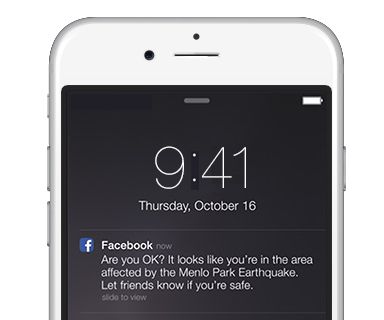Safety Check - a new Facebook tool that hopefully you'll never have to use

If you were caught up in the middle of a tsunami or an earthquake, I certainly hope your first thought wouldn’t be to reach to your smartphone to post a message to your Facebook page or Twitter account.
But, human nature being what it is, chances are that many would – after they have checked they are not in imminent danger – be keen to find out what the heck is going on by checking a social network, and reassure their friends and family that they are safe.
After all, we’re all connected more than ever before – and the internet age has meant that news of a natural disaster can spread within seconds around the globe. It’s understandable that you would want to tell your family that you are okay, and check that your loved ones are safe themselves.
Last week Facebook announced a new feature called “Safety Check” (not to be confused with the similarly-named Facebook “Privacy Checkup”) to help with precisely this situation.
Facebook’s Safety Check feature says it aims to help you “connect with friends and loved ones during a disaster”.
Facebook says that when a natural disaster occurs it will activate the service, for users who it determines might be in the affected area.
The social network says it will do this by looking at the city you have listed in your profile, the last last location you have registered if you have enabled “Nearby friends”, or the city where you appear to be using the internet from.
If Facebook believes you could be affected by the disaster, a notification will appear on your smartphone asking if you are safe.
You will then be able to simply press a button to confirm to your Facebook friends that you are safe, creating a News feed story confirming that you are ok.
Additionally, your friends can also make you as safe. If Facebook was wrong about your location, you can also tell the service that you are outside of the affected area.
Facebook says that “Safety Check” was inspired by work that the firm’s Japanese engineers did after the 2011 earthquake and tsunami which saw millions of people affected, and 400,000 people evacuated:
“During that crisis we saw how people used technology and social media to stay connected with those they cared about.
“Our engineers in Japan took the first step toward creating a product to improve the experience of reconnecting after a disaster. They built the Disaster Message Board to make it easier to communicate with others. They launched a test of the tool a year later and the response was overwhelming.
“Unfortunately, these kinds of disasters happen all too frequently. Each time, we see people, relief organizations and first responders turn to Facebook in the aftermath of a major natural disaster.
“These events have taught us a lot about how people use Facebook during disasters and we were personally inspired to continue work on the Disaster Message Board to incorporate what we`ve learned. This project soon became Safety Check, which will be available globally on Android, iOS, feature phones and desktop.”
Of course, you shouldn’t assume that just because someone hasn’t declared themselves to be “safe” via Facebook Safety Check that they are hurt or in danger. After all, in a major natural disaster there’s a strong chance that electricity lines may be down, cellular coverage disrupted and WiFi hotspot access non-existent.
Nonetheless, with so many people addicted to social networks like Facebook, it seems that such a service could put anxious minds at rest during a calamity.
Let’s all pray that you never feel the need to use it.
tags
Author
Graham Cluley is an award-winning security blogger, researcher and public speaker. He has been working in the computer security industry since the early 1990s.
View all postsRight now Top posts
How to Protect Your WhatsApp from Hackers and Scammers – 8 Key Settings and Best Practices
April 03, 2025
Outpacing Cyberthreats: Bitdefender Together with Scuderia Ferrari HP in 2025
March 12, 2025
Streamjacking Scams On YouTube Leverage CS2 Pro Player Championships to Defraud Gamers
February 20, 2025
How to Identify and Protect Yourself from Gaming Laptop Scams
February 11, 2025
FOLLOW US ON SOCIAL MEDIA
You might also like
Bookmarks











